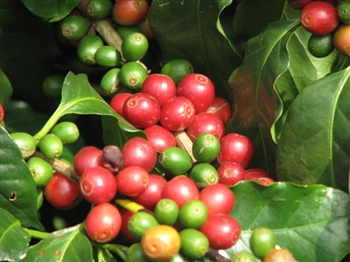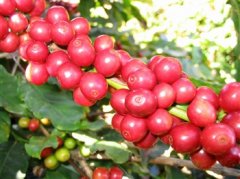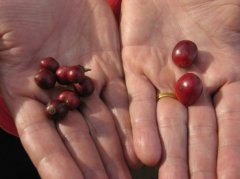Initial processing requirements of Yunnan Coffee (Arabica species)

Technical requirements for initial processing of small seed (Arabica) Coffee
1. Processing method
There are two processing methods for coffee beans made from fresh coffee fruit, namely, wet processing and dry processing. The first and second grade fruits are processed by wet method, and the third grade fruits are processed by dry method in areas without peeling machine and lack of water.
2. Processing technology
2.1 equipment and facilities for processing shall be equipped with fresh fruit collection pool, siphon pool, peeling machine, fermentation pool or non-metallic fermentation tank, tank, soaking pool, drying field or drying room, sheller, air separator, screening machine or grading screen, packaging bags, etc.
2.2 Water for processing
The content of various pollutants in coffee processing water should not exceed the requirements of the indicators listed in the table below.
Table G1 Index requirements of pollutants in Water for Coffee processing
Item
Index mark
PH value
6.5-8.5
Mercury, mg/L, ≤
0.001
Cadmium, mg/L, ≤
0.01
Lead, mg/L, ≤
0.05
Arsenic, mg/L, ≤
0.05
Chromium, mg/L, ≤
0.05
Cyanide, mg/L, ≤
0.05
Fluoride, mg/L, ≤
1.0
Chloride, mg/L, ≤
two hundred and fifty
Total number of bacteria, per mL, ≤
one hundred
Total coliform group, unit / L, ≤
three
3. Technology
3.1 Wet processing technology
3.1.1 fresh fruit cleaning: the ripe berries picked on the same day are placed in the collection pool and driven by water into the siphon pool for flotation and cleaning.
3.1.2 fresh fruit peeling: peeling fresh fruit with a peeling machine.
3.1.3 fermentation: the peeled beans are fermented in the fermentation tank or non-metal fermentation tank. Generally, the peeled beans are fermented for 48 hours. When you touch the beans with hands, the fermentation is complete.
3.1.4 Bean washing classification: put the fermented beans in the cleaning and grading tank or stir and knead repeatedly with running water in the bean washing tank, wash until there is no sour taste and residue, remove the empty skin, and divide the beans into one, two and three grades.
3.1.5 soaking: soak the washed beans in different soaking pools and soak them in drinking water for about 12 hours.
3.1.6 drying: the washed beans are dried in batches and graded to ensure that the moisture content of the beans is between 11Mui and 13%. The product at this time is coffee beans with shells.
3.1.7 shelling: remove the seed shell from the dried coffee beans with a shelling machine.
3.1.8 screening and grading: the beans from the sheller were blown off the seed coat by the air separator, and the bad beans were separated into different grades of coffee beans through different sieve holes.
3.2 dry process
3.2.1 Fruit drying: put the harvested fruit on the sun field and turn it over many times in the process of drying to speed up the drying. in case of rainy days, you need to recover the fruit and cool it indoors.
3.2.2 peeling: put the dried fruit into the sheller and remove the pericarp and seed shell.
3.2.3 Wind selection: the peeled beans are blown off the pericarp, seed shells and foreign bodies, and bad beans are removed by the air separator.
3.2.4 screening and grading: the beans after air selection are screened into different grades of coffee beans by the screening machine.
4 packing, marking, storage and transportation
4.1 Packaging
4.1.1 the packaging must be in a strong, clean, non-toxic, odorless and intact GB sack (qualified woven bags can be used for temporary coffee beans with shells).
4.1.2 each bag of products must be of the same grade and harvested in the same season.
4.2 Fla
The following items should be clearly marked on the front of each bag and in the bag: product name, product grade, implementation standard number, net content, producer name, origin, production date.
4.3 Storage and transport
In accordance with the provisions of the storage and transportation guide for bagged coffee beans in DB53/T 154.10 color 2006. (end)
Important Notice :
前街咖啡 FrontStreet Coffee has moved to new addredd:
FrontStreet Coffee Address: 315,Donghua East Road,GuangZhou
Tel:020 38364473
- Prev

How to treat fresh coffee fruit into raw coffee beans
The variety of coffee treated with raw beans certainly determines the natural flavor, but the treatment of raw beans determines the acquired quality. Selected coffee attaches great importance to flavor and quality, so it pays special attention to the technology and details of processing. Harvest: the harvest method is one of the criteria for judging selected coffee. if calculated from the time of germination, Arabica coffee will take about 5 years to blossom and bear fruit. Brazil
- Next

The knowledge of coffee beans you don't know, Robusta.
People always habitually look at things in dichotomy, good and bad, good and evil, good and bad. The same is true in the world of coffee. Arabica coffee beans are always classified as good, while its distant relative, Robusta, is often classified as bad. We might describe it this way, if Arabica is a gift from an angel.
Related
- Guji coffee producing area of Guji, Ethiopia: Humbela, Shakiso, Wulaga
- What is the most expensive variety of Qiloso in BOP multi-variety group?
- How to store the coffee beans bought home?
- Why are Yemeni coffee beans so rare now?
- Ethiopian Sidamo all Red Fruit Sun Sun Santa Vini Coffee beans
- SOE is mostly sour? What does it mean? Is it a single bean? what's the difference between it and Italian blending?
- Is Italian coffee beans suitable for making hand-brewed coffee?
- How to choose coffee beans when making cold coffee? What kind of coffee beans are suitable for making cold coffee?
- Just entered the pit to make coffee, what kind of coffee beans should be chosen?
- Can only Japan buy real Blue Mountain Coffee? What are authentic Jamaican Blue Mountain coffee beans?

